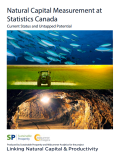Through in-depth case studies in Ucayali and San Martin, Peru, this document elaborated jointly by the Global Green Growth Institute (GGGI), the German Development Institute (DIE) and the International Centre for Research in Agroforestry (ICRAF) develops a typology for family producers based on quantitative and qualitative research. This typology includes land use, behavioral incentives and recommendations for the National Forest and Wildlife Plan that promote the full participation of family producers in the forest economy.
The topic of biodiversity loss has been the subject of a vast and growing scientific and economic literature. Species are estimated to be going extinct at rates 100 to 1000 times faster than in geological times. Globally, terrestrial biodiversity is projected to decrease by a further 10% by 2050. As with biodiversity, the planet has also experienced major losses in the services derived from ecosystems. During the last century, for example, the planet has lost 50% of its wetlands, 40% of its forests and 35% of its mangroves. Around 60% of global ecosystem services have been degraded in just 50 years. While there is a large and growing literature on the values associated with the services that ecosystems provide, much less has been done in analysing the causality in the other direction – i.e. in assessing the linkages from changes in ecosystem services to the functioning of the economy. This report contributes to an effort to identify environmental pressures under different structural and environmental policy assumptions and the associated damages that will result under different economic scenarios to 2050.
The Little Green Data Book provides approximately 50 indicators for more than 200 countries based on World Development Indicators 2016 and its online database. Key indicators are organized under the headings of agriculture, forestry, biodiversity, energy, emission and pollution, and water and sanitation. Data is presented for the regions of East Asia and Pacific, Europe and Central Asia, Latin America and the Caribbean, Middle East and North Africa, South Asia, and Sub-Saharan Africa.
Several of these indicators have the potential to measure progress on the SDGs. These indicators measure the use of resources and the way human activities affect both the natural and the built environment including: measures of natural resources (forest, water, and cultivable land) and degradation (pollution, deforestation, loss of habitat, and loss of biodiversity).
The 2016 edition measures sustainability by expanding the conventional way of measuring national saving to include natural resource deplate and degradation of the environment as well as investment in human capital.


The UNDP-UNEP Poverty Environment Initiative (PEI) offers a unique way of tackling these issues together by offering policy options to governments on how sustainable use of natural resources can help reduce poverty and maintain economic growth. With strong support from six donors globally, PEI in Asia Pacific is working with nine countries to mainstream pro-poor natural resource management into economic policies and decision making to achieve more inclusive green economies.
